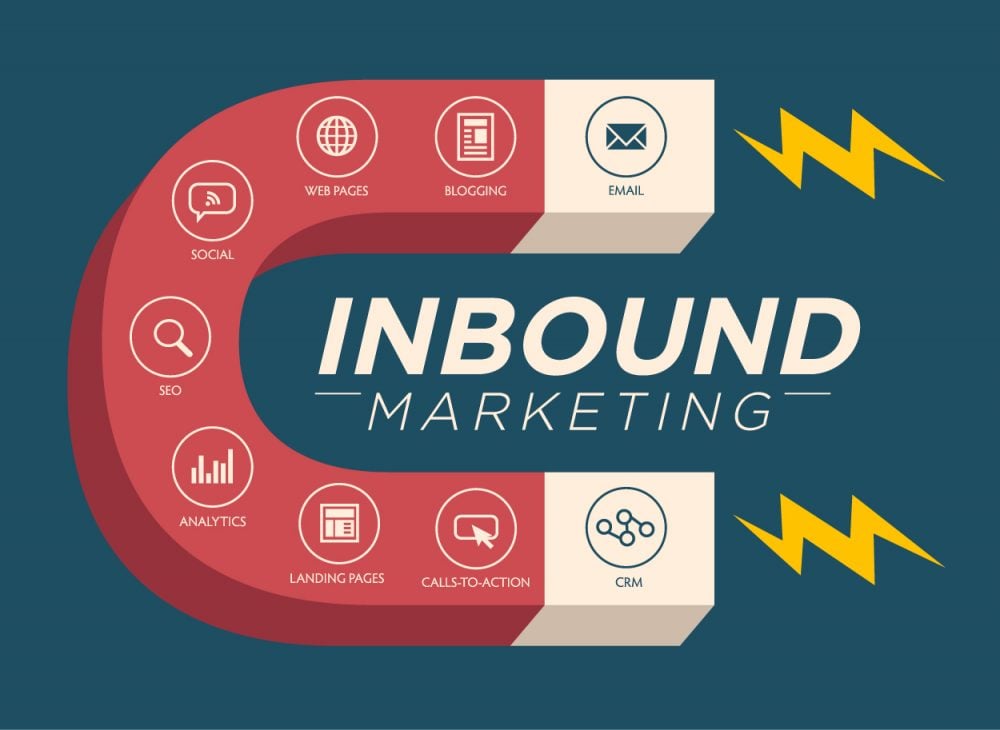
You may be attempting to understand what inbound marketingis. Imagine a magnet, it is designed to have one end that draws in and one end that pushes away when it is lined up.
Because it is a strategy that is meant to attract clients and draw them in without any interruptions, inbound marketing is comparable to the pulling end. Inbound marketing seeks to develop close ties with customers, in contrast to other marketing strategies, which may sometimes function like the repelling end, with heavy-handed efforts that push people away.
This post will provide a more in-depth explanation of what inbound marketing is and how it contributes to the development of client loyalty.
Inbound Marketing
Inbound marketing is a strategy that aims to attract the attention of a consumer. Putting the content out there for the customer to locate on their own is the goal of digital inbound marketing campaigns. Inbound marketing relies heavily on SEOas it allows firms to appear in search results for the queries that customers are asking and then provide them with content.
For example, the material may be an asset on a landing page, a blog, or a webpage. Social media is another critical tool for inbound marketing as it makes it simple for brands to interact with consumers and join in on discussions.
Producing high-quality content that consumers can access while doing research or posing queries is the secret to inbound marketing. To find out how users engage with content and whether the information they find converts, you need to employ analytics and statistics.
Why Is Inbound Marketing Important?
The demands of customers are addressed through inbound marketing. There are a variety of marketing categories that could benefit from incorporating inbound marketing tactics into their campaigns.
Some of these categories include content marketing, email marketing, social media marketing, and digital marketing. When it comes to its technique, inbound marketing is less concerned with sales and more concerned with the production of content and the provision of customers with comprehensive information regarding your brand and products.
As customers search for knowledge about items, inbound marketing may assist in providing them with information. Over half of the people who participated in a recent poll conducted by Amazon regarding customer behavior and product discovery reported conducting product research online.
Through the use of inbound marketing, companies may get ready for this by ensuring that the information and resources that their consumers require are accessible on their website or through their social media platforms.
Inbound Vs. Outbound Marketing
Through slower and more subtle channels, inbound marketing is all about drawing customers to you rather than the other way around. Inbound marketing is like a spider that builds a complex web and then waits patiently for an insect to fall into it. Inbound marketing is willing to play the long game.
The opposite of inbound marketing is outbound marketing, which is more direct and uses methods such as commercials and sponsored advertisements to communicate with people in a loud and precise manner. Although it similarly strives to establish close ties with its customers, it employs completely different strategies to accomplish this objective.
Outbound marketing reaches a large number of people, and it is a beautiful method for bringing your company to the forefront of attention, particularly if you are attempting to develop a brand or connect with a new audience.
Components Of Inbound Marketing
Successful inbound marketing follows a specific process. Using inbound marketing, you may cultivate enduring relationships with your clients and boost sales and profits. You give customers, prospects, and loyal customers the information they want and desire at every turn in their relationship with your business.
With practical information and pertinent material that users find helpful, inbound marketing attracts clients to your website.
You take on a joint role in their achievement. Stated differently, your website's income rises when your clients succeed and are satisfied. The majority of marketers list these four essential inbound marketing tasks;
- Attract
- Convert
- Close
- Delight
You draw in new visitors, close leads, please existing ones, and draw in outsiders. Let's examine each of these four tasks in further detail.
Attract
Getting clients is a straightforward idea. However, attracting clients involves more than just boosting your on-page SEO and producing a constant stream of fresh content. You need to identify who your ideal client is before you can even begin to consider your content strategy or spend many hours researching search engine optimization.
Take some time to create a buyer persona or an online persona representing the kind of client that will consistently visit your website for information and will come to you first when they need the kinds of things you sell.
Think about the material you may offer that corresponds with the online searches of your potential client. Search engine optimization (SEO) is what you do at that time. Not only does Google consider your keywords when ranking your website, but you may also reach a wider audience by using often-searched keyword phrases. You may then create valuable, original material.
Convert
The goal is to turn a website visitor into a lead once they have been drawn in. A lead is an individual who provides you with information (such as name, email address, and preferred content) in exchange for further information about your business.
How do website users turn into leads? A call-to-action, or CTA, may help you turn website visitors into leads. One possible CTA is "Buy now!" However, it may also be a request to download an ebook, arrange a demo, or be joined to your marketing email list.
Enough information is also included in quality leads to support your outbound marketing campaigns. Customers who request to be included in your email lists and provide you with their email addresses are interested in what you have to offer.
Close
Digital marketing is all about making sales online, right? It's time for your sales team—or you, if you're a solo entrepreneur working alone to clinch the deal once you've drawn in your ideal client and turned them into a lead.
Remember that a prospect might need to go through your sales funnel. A large number of leads will need more time to prepare to buy from you. But persistence with grace pays off.
Until your lead completes the transaction and turns into a paying client, there will often be a back-and-forth procedure. Best wishes! A sale was made by you! To get them to buy more from you in the future, you must, nonetheless, keep making them happy.
Delight
The enjoyable part of digital marketing begins at the pleasure stage. Your consumer has been effectively led through the buyer's journey by you. Now, it's your content marketing team's responsibility to stay in contact and provide them with further details on the solutions they want. Your sales team must ensure that your items fulfill customer expectations.
Benefits Of Inbound Marketing
Reach The Right Audience In The Right Place To Generate Quality Traffic
You may attract your target clients and fulfill your digital marketing goals by concentrating your inbound marketing approach on reaching the appropriate people in suitable locations. This is a cheaper option than paying to get traffic from non-converting website visitors.
Boost Confidence
The main goal of inbound marketing is to provide prospective clients with the knowledge they seek even if they are unaware of it, excitingly and imaginatively. It's not about trying to force unwelcome purchases at every turn.
The idea behind inbound marketing is to position your company as a trustworthy and helpful source so that when the time comes to make a purchase, people will find you first.
Protect From Over-Reliance On One Channel
Lower the risk associated with relying solely on one channel by chasing excellent traffic from a range of sources, such as organic search, social media referrals, and referrals from other websites showcasing your incredible work.
8 Inbound Marketing Strategies
The best inbound marketing techniques revolve around developing a playbook that businesses can go to again and time again.
These tactics enable scalability and are quantifiable using measures like social media analytics, sales, ROI, retention rates, and survey responses. There are always new tactics to try, so it's critical to keep up with what your target audience is interested in using.
Share Personalized Content
It is worth emphasizing again and again. Consumers like to view stuff that immediately helps and pertains to them. An essential shoe advertisement is less compelling than a creative movie explaining why your all-terrain sandals are the most excellent option for Appalachian Trail hikers in their 40s.
With customers expecting a more customized experience, personalized inbound marketing based on their choices is only going to become more and more popular. Businesses that can offer this degree of customization will probably see an increase in sales and customer loyalty.
Offer Guest Posts
Despite several changes in the digital world, blogs have remained popular for a long time. A blog offers a firm the chance to reach a large number of new clients, regardless of whether it is currently up and running or just getting started.
Being an expert in the field is one of the simplest methods to provide buyers the assurance that something they could be spending money on is worthwhile. Including guest blogs from vehicle manufacturers or NASA engineers might be crucial for success if you're attempting to market flying automobiles.
Employ Seo
Search engine optimization is crucial for success online in the digital era. Remember that Google uses search intent to determine how to match your content to its measurements.
Google considers several factors when determining a page's ranking since different individuals search for different things. You continue to work on SEO even after your page is published.
Embrace Influencers
Similar to QR menus, influencers are ideas that people either love or detest. Regardless of how you feel about them, though, they are here to stay for the foreseeable future and may significantly support your inbound marketing initiatives.
Influencers seem more honest and personable than celebrities, yet celebrities are no longer seen as authentic when they promote a company. Businesses may use the relationship influencers have with their followers to promote their products, reach their target market, and establish brand trust.
Consider AI
Though it may sound futuristic, artificial intelligence (AI) has been around for a long and is a part of daily life, even if you aren't constantly aware of it. However, this does not imply that you have to use chatbots or artificial intelligence (AI) to create content.
Instead, integrate AI into your inbound marketing strategy by leveraging it to help with targeted ad creation, better understanding buyer demands and consumer behavior, obtaining insightful customer data, and following up with abandoned carts.
Make Surveys
Creating surveys and evaluating survey results don't have to be difficult tasks. A web link collector that collects replies and presents data summaries on a console may be obtained from Mailchimp.
Maintain Your Channels And Platforms
If you spent hours creating the most engaging and brief blog post, only to find the site it is hosted on needs to be fixed, that would be such a waste. Verify that there are no problems on your website that might impede a customer's experience.
Verify that links and CTAs are functioning correctly by testing them. Next, ensure that users may easily transition across channels, for example, from your website to your social media material.
Put Automation Into Practice
You don't have to closely monitor your inbound marketing plan after launch, even if developing one will require a lot of labor. Automation technologies, such as email marketing software and social media management systems, may significantly reduce mistakes, save money, and free up more time and resources.
Automation is the process of organizing your work to help you maximize your potential most effectively. Because everyone has access to automation technologies, it also helps level the playing field between big and small enterprises.
Types Of Content To Use In Inbound Marketing
Strategies for inbound marketing wouldn't work as well without quality content. By distributing diverse information across several platforms, brands may effectively reach their intended audience no matter where they are on the internet.
Blog Posts
One of the most popular types of content marketing is blogging since it can be a very beneficial resource for clients looking for information. Blogs with search engine optimization assist companies in obtaining top-of-funnel traffic and a good SERP ranking.
Blogs can alleviate the problems that customers have and then push them toward further information that either encourages them to buy something or get in touch with a salesperson.
These days, blogs and other content types need to be mobile-friendly as search engines like Google rank web pages based on their mobile versions. Search engine results pages with quick loads and easy-to-use interfaces are more likely to rank well.
Landing Pages
Landing pages are a crucial component of a successful inbound strategy, which makes sense, given that inbound marketing aims to attract visitors to your website. Landing pages need to be optimized for the brand's sales funnel in addition to search engines.
This implies that every landing page should have a distinct objective and should use clever linking techniques to link to additional pertinent information. For instance, a lot of marketers pair optimized landing pages with pay-per-click (PPC) advertisements.
Therefore, if a PPC advertisement for a particular keyword shows on a search engine result page, it needs to direct the reader to a high-quality landing page that provides further details about that phrase. Compelling calls to action can then move visitors down the funnel.
Case Studies
Before they spend their hard-earned money on a service, modern consumers expect assurances of its worth. B2B clients are also responsible for making sure their budgets are used prudently and with the most minor level of risk. Case studies give companies a concrete means of showcasing the worth of their products.
Readers love tales, and a substantial case study is precisely that—a gripping story. Case studies give potential buyers a fun way to learn about businesses by sharing quotations and experiences from happy customers. Furthermore, case studies are a helpful kind of gated content in which potential customers exchange contact details.
Infographics
Whether you agree that 65% of people learn best visually or not, visuals may be a potent tool for communicating crucial information. Infographics are shared by people three times more frequently than other kinds of material. Infographics give readers relevant information without consuming a lot of time because of their eye-catching visuals and simple text.
Furthermore, not every infographic has to be cartoonish. Infographics are a standard tool used by B2B businesses to communicate information interestingly while staying true to their standard voice and tone.
FAQs About Inbound Marketing
What Is The Primary Goal Of Inbound Marketing?
The primary goal of inbound marketing is to attract, engage, and delight customers by providing content that aligns with their needs and interests.
How Does Social Media Contribute To Inbound Marketing?
Social media helps amplify content, increases brand visibility, and facilitates engagement with the target audience, promoting a more personalized connection.
What Is The Significance Of Lead Nurturing In Inbound Marketing?
Lead nurturing involves building relationships with potential customers at each stage of the buyer's journey, guiding them toward making a purchase decision.
A Quick Recap About Inbound Marketing
A successful strategy for drawing in and interacting with your target market, creating enduring connections, and promoting business expansion is inbound marketing. However, it's crucial to comprehend your target audience and the information and answers they are looking for before you begin.
Once you understand the requirements and preferences of your audience, produce content that speaks to them. Businesses may establish a system of enduring loyalty and authentically engage with customers by utilizing inbound marketing techniques.





